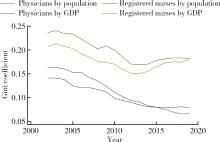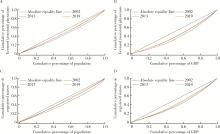北京大学学报(医学版) ›› 2022, Vol. 54 ›› Issue (3): 477-482. doi: 10.19723/j.issn.1671-167X.2022.03.012
中国卫生人力配置公平性变化趋势分析
- 1. 北京大学公共卫生学院卫生政策与管理学系, 北京 100191
2. 北京大学公共卫生学院, 北京 100191
3. 中卫护理信息管理研究院, 北京 100086
Analysis of variation trend in health workforce equity allocation in China
Wu-ping ZHOU1,Shu-han YANG2,Nan MU3,Wei-yan JIAN1,*( )
)
- 1. Department of Health Policy and Management, Peking University School of Public Health, Beijing 100191, China
2. Peking University School of Public Health, Beijing 100191, China
3. Zhongwei Institute of Nursing Information, Beijing 100086, China
摘要:
目的: 分析我国卫生人力配置公平性变化的长期趋势,为我国卫生健康体系更加均衡有序发展提供参考。方法: 使用基尼系数评价地区间卫生人力配置的公平性,分别计算基于人口分布、地区生产总值分布的医生和护士配置基尼系数。结果: 2019年我国千人执业(助理)医师数为2.77人,千人注册护士数为3.18人。2002年执业(助理)医师按人口分布的基尼系数为0.141,2014年降至0.081,随后保持稳定;2002年注册护士按人口分布的基尼系数为0.164,2018年降低至0.066。2002年执业(助理)医师按地区生产总值(gross domestic product,GDP)分布的基尼系数为0.236,2013年降至0.169,随后升高至0.183,并保持稳定;2002年注册护士按GDP分布的基尼系数为0.206,2013年降低至0.150,随后逐年升高至2019年的0.180。2002年注册护士按人口配置的公平性比执业(助理)医师配置公平性更差,2016年首次反超执业(助理)医师。结论: 中国各省卫生人力配置公平性有所改善,但是地区间的公平性改善遇到瓶颈,西部地区卫生人力配置仍然相对匮乏。尽管护理人力配置公平性赶超执业(助理)医师,从绝对水平看,每千人执业(助理)医师数接近西方发达国家水平,而注册护士数差距较大。建议有关部门做好卫生人力培养长期规划,进一步加大西部地区卫生人力培养与引进政策,并借助医疗数字化转型、互联网医疗增加西部地区医疗服务供给,同时进一步加大护理高等教育资源投入,积极应对人口老龄化。
中图分类号:
- R192
| 1 |
邱卓英, 郭键勋, 杨剑, 等. 康复2030:促进实现《联合国2030年可持续发展议程》相关目标[J]. 中国康复理论与实践, 2017, 23 (4): 373- 378.
doi: 10.3969/j.issn.1006-9771.2017.04.001 |
| 2 |
中国共产党中央委员会, 中华人民共和国国务院. "健康中国2030"规划纲要[J]. 中国实用乡村医生杂志, 2017, 24 (7): 1- 12.
doi: 10.3969/j.issn.1672-7185.2017.07.002 |
| 3 |
孙新章. 中国参与2030年可持续发展议程的战略思考[J]. 中国人口·资源与环境, 2016, 26 (1): 1- 7.
doi: 10.3969/j.issn.1002-2104.2016.01.001 |
| 4 | 周靖. 中国居民健康不平等的经济社会影响因素研究[D]. 武汉: 华中科技大学, 2013. |
| 5 | 李立清, 许荣. 中国居民健康水平的区域差异分析[J]. 卫生经济研究, 2015, (1): 14- 20. |
| 6 | 孙菊. 中国卫生财政支出的健康绩效及其地区差异——基于省级面板数据的实证分析[J]. 武汉大学学报(哲学社会科学版), 2011, 64 (6): 75- 80. |
| 7 |
李海明, 王有强. 卫生资源投入与健康中国建设: 基于价值的卫生系统视角[J]. 中国行政管理, 2018, (8): 65- 69.
doi: 10.3782/j.issn.1006-0863.2018.08.09 |
| 8 | 程立辉, 柏亚妹, 宋玉磊, 等. 基于集聚度的我国护理人力资源配置分析[J]. 中国医院管理, 2018, 38 (10): 69- 71. |
| 9 | 黄燕, 孙蓉, 朱鹏瞻, 等. 基于资源同质性假设的护理人力资源配置现状及公平性分析[J]. 中国医院管理, 2021, 41 (5): 83- 86. |
| 10 | 苏彬彬, 杜鹃, 贾金忠, 等. 中国护理人力资源现状及其配置研究[J]. 中国卫生政策研究, 2018, 11 (12): 60- 65. |
| 11 | 杨展, 李宁秀. 2013—2017年我国护理人力资源配置现状及公平性研究[J]. 现代预防医学, 2021, 48 (5): 858- 861. |
| 12 |
张小娟, 朱坤. 2004—2015年我国卫生人力资源配置公平性趋势研究[J]. 中国全科医学, 2018, 21 (1): 82- 87.
doi: 10.3969/j.issn.1007-9572.2018.01.018 |
| 13 | 黄阿红, 方鹏骞, 陶思羽, 等. 2011年和2016年我国护理人力资源配置公平性比较研究[J]. 中国卫生经济, 2018, 37 (1): 70- 73. |
| 14 | 国家卫生健康委员会. 中国卫生统计年鉴[EB/OL]. (2019-06-13)[2021-10-20]. http://www.nhc.gov.cn/mohwsbwstjxxzx/tjzxtjcbw/tjsj_list.shtml. |
| 15 | 中国知网. 中国经济社会大数据研究平台[EB/OL]. (2021-02-01)[2021-10-20]. https://data.cnki.net/Yearbook/Single/N2020020200. |
| 16 | 国家统计局. 国家数据中心[EB/OL]. (2021)[2021-10-20]. https://data.stats.gov.cn/. |
| 17 |
龚红娥. 基尼系数及其实际应用[J]. 市场与人口分析, 2002, 8 (6): 35- 40.
doi: 10.3969/j.issn.1674-1668.2002.06.007 |
| 18 |
叶礼奇. 基尼系数计算方法[J]. 中国统计, 2003, (4): 60.
doi: 10.3969/j.issn.1002-4557.2003.04.036 |
| 19 | 洪兴建. 基尼系数合意值和警戒线的探讨[J]. 统计研究, 2007, 24 (8): 84- 87. |
| 20 | 赵红, 王小合, 应心, 等. Lorenz曲线和Gini系数在卫生资源配置公平性评价应用中的几个问题与思考[J]. 中国卫生经济, 2012, 31 (4): 25- 27. |
| 21 | O'Donnell O , O'Neill S , van Ourti T , et al. Conindex: Estimation of concentration indices[J]. Stata J, 2016, 16 (1): 112- 138. |
| 22 | 万广华. 不平等的度量与分解[J]. 经济学(季刊), 2008, 8 (1): 347- 368. |
| 23 | 毛宗福, 王永棣, 刘继强, 等. 我国卫生人力资源及其研究现状[J]. 中华医院管理杂志, 2003, 19 (1): 16- 20. |
| 24 | 夏冕, 罗五金. 我国卫生人力资源配置的公平性分析[J]. 医学与社会, 2009, 22 (2): 36- 38. |
| 25 | 中共中央办公厅. 中共中央办公厅国务院办公厅关于印发《西部地区人才开发十年规划》的通知[EB/OL]. (2002-02-10)[2022-03-14]. https://rsj.sh.gov.cn/tgwyxzfgwj_17255/20200617/t0035_1388242.htm. |
| 26 | 中共中央国务院. 中共中央国务院关于新时代推进西部大开发形成新格局的指导意见[EB/OL]. (2020-07-02)[2022-03-14]. http://www.gov.cn/zhengce/2020-05/17/content_5512456.htm. |
| 27 | 杨辉, 韩建军, 许岩丽. 中国全科医生队伍建设的发展、挑战与展望[J]. 中国全科医学, 2019, 22 (19): 2267- 2279. |
| 28 | 朱劲松. 互联网+医疗模式: 内涵与系统架构[J]. 中国医院管理, 2016, 36 (1): 38- 40. |
| 29 | 中华人民共和国国民经济和社会发展第十四个五年规划和2035年远景目标纲要[J]. 中国水利, 2021(6): 1-38. |
| 30 | WHO. Global health workforce statistics database[EB/OL]. (2022-01-24)[2022-05-16]. https://www.who.int/data/gho/data/themes/topics/health-workforce. |
| 31 | 中华人民共和国国务院办公厅. 关于推动公立医院高质量发展的意见[EB/OL]. (2021-06-04)[2022-03-15]. http://www.gov.cn/zhengce/content/2021-06/04/content_5615473.htm. |
| 32 | 穆楠, 周吴平, 霍珊珊, 等. 1990年至2019年我国护理人力资源变化趋势分析[J]. 中华医院管理杂志, 2021, 37 (10): 848- 851. |
| 33 | 鲁晓明, 孙喆. 我国长期护理保险制度的构建[J]. 江汉论坛, 2022, (3): 108- 115. |
| [1] | 郭岩, 谢铮. 用一代人时间弥合差距——健康社会决定因素理论及其国际经验[J]. 北京大学学报(医学版), 2009, 41(2): 125-128. |
| [2] | 星一, 郭岩. 秦巴扶贫项目地区卫生服务不公平现状分析[J]. 北京大学学报(医学版), 2001, 33(6): 501-506. |
|
||




